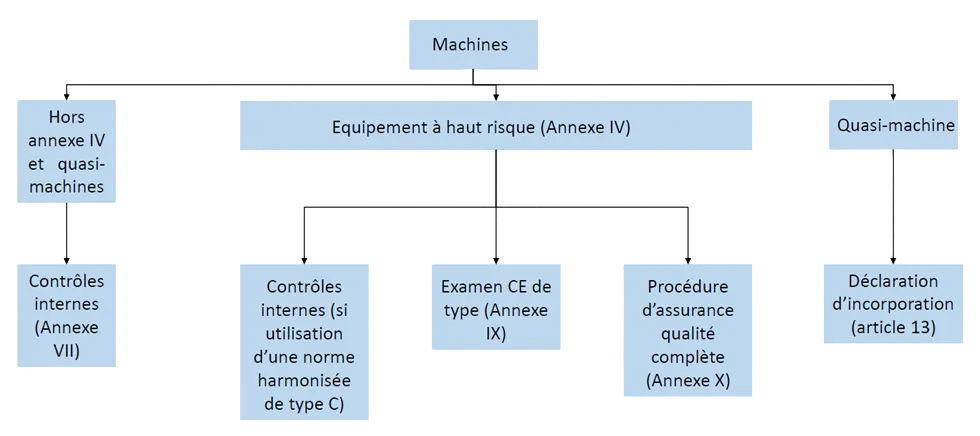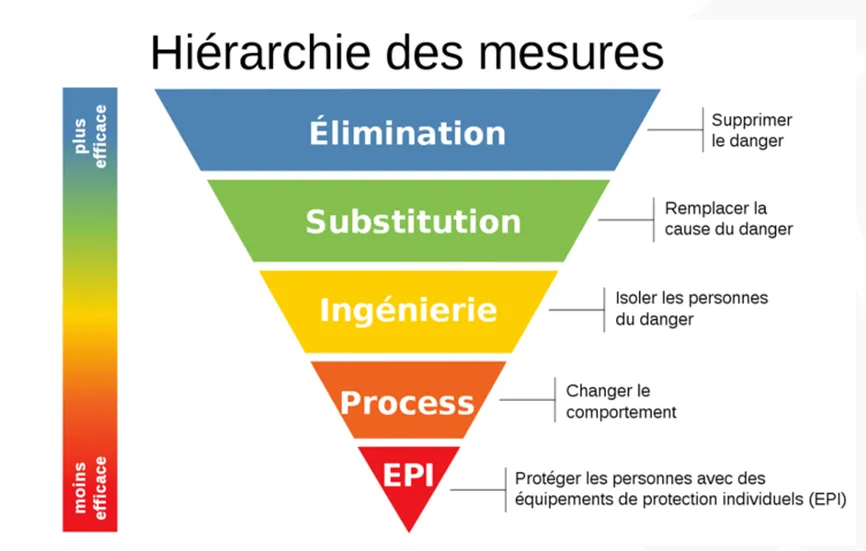Machinery Directive 2006/42/EC
Compliance and marketing
Why is the Machinery Directive essential?
Directive 2006/42/EC, known as the Machinery Directive, defines the essential health and safety requirements (EHSRs) applicable to industrial equipment before it is placed on the European Union market. Its aim is to ensure the safety of operators and users, while facilitating the free movement of compliant machinery within the EU. Our services enable manufacturers, importers and distributors to :
- Ensure that machinery complies with safety requirements.
- Obtain CE marking and guarantee that machinery is placed on the market legally.
- Draw up the technical file and carry out the risk analysis.
- Use harmonised standards to facilitate compliance.
- Collaborate with Notified Bodies if necessary.

Scope and obligations of manufacturers
- Machinery: any assembly of linked parts, equipped with a drive system, intended for a specific application.
- Safety components: elements providing a protective function.
- Interchangeable equipment: devices which modify the main function of a machine.
- Lifting accessories and quasi-machines (incomplete machines to be integrated into a final assembly).
- Design machines that comply with the essential safety requirements (EESS).
- Carry out a risk analysis and compile a technical file.
- Affix the CE marking after following the appropriate assessment procedure.
- Draw up an EC declaration of conformity and provide instructions.
- Use a Notified Body for certain high-risk machines.
The key elements of the Machinery Directive
Essential health and safety requirements (EHSR)
EHSR covers many aspects of machine safety, including :
- Mechanical safety (protection against cuts, crushing, falling parts, etc.).
- User safety for protection against electric shock and electromagnetic compatibility (EMC).
- Thermal and fire risk.
- Protection against hazardous substances and radiation.
- Ergonomic measures and noise and vibration reduction.
Harmonised standards and certification
Applying harmonised standards makes it easier to demonstrate compliance with the essential requirements. Some key standards :
- EN ISO 12100: General principles for design, risk assessment and risk reduction.
- EN 60204-1: Safety of machinery - Electrical equipment of machines
- EN ISO 13849-1: Reliability of safety-related control systems.
- ISO 13857: Safety distances to prevent access to hazardous areas.
- Etc
Machinery designed in compliance with harmonised standards is presumed to comply with the directive.
Conformity assessment procedures
- Internal manufacturing control : The manufacturer carries out the assessment himself and compiles the technical file (except if annex 4, otherwise annex x ok).
- EC type-examination: For high-risk machinery (annex IV of the directive), the intervention of a Notified Body is required.
- Full quality assurance: Assessment of a quality system covering design and manufacture.

Talk to our CE marking experts
Technical file and risk analysis
- Description of the machine and how it works.
- Drawings and technical diagrams.
- List of harmonised standards applied.
- Test results and certificates of conformity.
- Risk analysis and solutions implemented.
- The risk assessment process is a documented physical examination and machine inspection carried out in accordance with the recommendations of national standards.
- Risk assessments must be dynamic, risks must be re-assessed in the event of changes;
- The risk assessment must cover all phases of its life cycle (transport, use, disposal, etc.).
- The risk assessment must also cover all persons interacting with the machine.
- The risk assessment must take account of normal use and reasonably foreseeable misuse.
- Define the intended use and reasonably foreseeable misuse
- Identify the hazardous phenomena
- Analyse the risks associated with the hazardous phenomena
- Estimate the risks
- If the risk is not tolerable, reduce the risk
- Elimination / substitution of the hazard.
- Implementation of protective measures (isolation from the hazard).
- Informing users of risks (manuals, training and PPE).

Testing and validation of compliance
- Mechanical safety: strength, stability and fatigue tests.
- Electrical safety: checking circuits, insulation, earthing.
- EMC testing: electromagnetic compatibility to ensure interference-free operation.
- Thermal and fire protection testing.
Regulation 2023/1230: Transition and development of the directive
- Uniform application without national transposition, avoiding regulatory divergences.
- Incorporation of new cybersecurity and artificial intelligence requirements.
- Extended definitions of machinery and related products.
- Digitisation of technical documentation and instruction manuals.
- Clarification of the obligations of manufacturers, importers and distributors.
Multi-regulatory compliance for CE marking
- Identify specific risks (electrical, ATEX, EMC, etc.).
- Check if other directives are applicable in addition to the Machinery Regulations.
- Apply the relevant harmonised standards for each regulation.
- Carry out the necessary tests and assessments (often with Notified Bodies in certain cases).
- Compile a complete technical file of conformity.
- Draw up an EU Declaration of Conformity mentioning all applicable directives.
- Affix the CE marking only once all the requirements have been met.
Why choose the expertise of the Emitech Group?
- Regulatory support: analysis of applicable requirements.
- Risk assessment and compilation of technical file.
- Laboratory tests and trials to guarantee compliance.
- Assistance in obtaining CE marking and certification.
- Involvement of a Notified Body if necessary.
Related Services
Needs
Discover a selection of additional resources that explore topics related to this page including regulatory contexts, technical articles, and specific areas of expertise. These materials provide further insight to help you better understand the key challenges and available solutions.
Contact us for a quote












